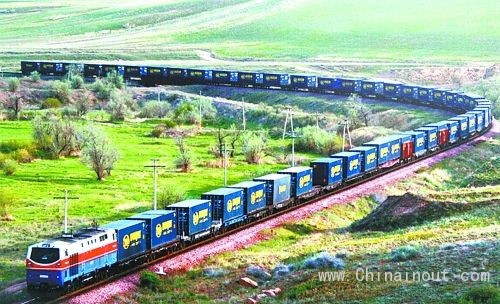
郑欧班列
2013年7月18日首次开行的郑欧班列,从郑州出发,在11天半的时间里,途经哈萨克斯坦、俄罗斯、白俄罗斯、波兰、德国,终点站在德国汉堡。每周三、五各有一趟列车准时从郑州发车至汉堡,每周四、六各有一趟列车从汉堡发车至郑州。
郑欧班列以安全、稳定、快捷的优势,还吸引了部分日本、韩国企业。为此,2015年以来,郑欧班列首创了“公-海-空-铁”国际多式联运模式,专门为日韩货物经郑州转运亚欧提供服务,成为丝绸之路经济带和海上丝绸之路的重要结合纽带。
郑欧班列首创的“国际多式联运物流模式”得到了中国交通运输部和海关总署的关注。目前两个权威机关已确定,将依托郑州国际陆港,筹建中部地区最大的“国际多式联运中心”,使国际货运的相关手续更加便利快捷。
郑州是中国的铁路、高速公路、高速铁路枢纽,物流运输距离近、成本低,是郑欧班列能够成为中国目前开行的21列中欧班列中的佼佼者的关键因素。
据了解,郑欧班列不断探索创新与丝绸之路经济带沿途国家合作,集散货物半径不断扩大,除郑州-汉堡线路外,2015年郑欧班列还增开了郑州-阿拉木图、郑州-莫斯科等线路。
Zhengzhou-European trains is the first public international freight trains connecting Japan, Korea to Europe on the Silk Road economic belt.
On July 18, 2013, for the first time, Zhengzhou-Europe trains started from Zhengzhou, in 11 half days, via Kazakhstan, Russia, Belarus, Poland, Germany, reached in the terminal Hamburg, Germany. Every Wednesday, Friday, there is a train on time departing from Zhengzhou to Hamburg, every Thursday, Saturday, there is a train from Hamburg to Zhengzhou.
Zhengzhou-European trains are safe, stable and efficient, and attracted some of the Japanese and South Korean companies. since 2015, Zhengzhou-European trains pioneered the "Highroad - Sea - Air - Railway" international multimodal transport mode, especially providing transshipment service for Japanese and Korean cargo shipped to Europe through Zhengzhou, to become an important binding tie between the Silk Road economic belt and the Marine Silk road.
Zhengzhou-European trains initiate "international multimodal logistics model", which attracted the attention of the Chinese Ministry of Transport and the General Administration of Customs. Currently two authoritative have identified, based on the Zhengzhou International land port, we’ll build the central region's largest "International Intermodal Center" to make the relevant international freight procedures more convenient and efficient.
Zhengzhou is a transport junction of China's railway, highway and high-speed railway, short logistics transport distance and low cost, is a key factor for Zhengzhou-European trains to become China's current leader in 21 sino-European trains.
It is understood that Zhengzhou-European trains continue to explore new innovative economic cooperation with countries alongside the silk road economic belt, thus expanding the radius of the distribution of goods, in addition to Zhengzhou - Hamburg line, in 2015 Zhengzhou-European trains also increase Zhengzhou - Almaty line and Zhengzhou - Moscow line.











